Evaluating the Impaction of Coal Mining on Ordovician Karst Water through Statistical Methods
Abstract
:1. Introduction
2. Study Area and Data
2.1. Hydrogeological Conditions
2.2. Data
2.3. The Impacting Mode of Coal Mining on Karst Water
3. Methods
3.1. Trend Analysis of Different Influences
3.1.1. Mann–Kendall Method
3.1.2. Innovative Trend Analysis (ITA) Method
3.2. Correlation Analysis between Influences
3.2.1. Multi Regression Analysis
3.2.2. Wavelet Coherence
4. Results and Discussion
4.1. The Importance of Coal Mining to Karst Water Resources
4.2. The Trend of Influences Changes under Mining Conditions
4.3. The Influence Degree of Each Factor under Mining Conditions
4.4. The Trend of Influence Degree of Each Factor under Natural or Human Conditions
4.4.1. Data Preprocessing
4.4.2. Time-Frequency Distribution of Coherence
4.5. Prospects for Future Research
5. Conclusions
Author Contributions
Funding
Acknowledgments
Conflicts of Interest
References
- Leibundgut, C. Vulnerability of Karst Aquifers; IAHS Publication: Wallingford, CT, USA, 1998. [Google Scholar]
- Wang, W.T.; Liang, Y.P.; Wang, Z.H.; Zhao, C.H. Characteristics of climate change in northern China and its effect on groundwater in karst areas. Hydrogeol. Eng. Geol. 2012, 45, 332–338. [Google Scholar]
- Hao, Y.H.; Wang, W.; Wang, G.Q. Effects of Climate Change and Human Activities on the Karstic Springs in Northern China: A Case Study of the Liulin Springs. Act. Geol. Sin. 2009, 83, 138–144. [Google Scholar]
- Yuan, D.X. Chinese Karst; Geological Publishing House: Beijing, China, 1993. [Google Scholar]
- Zhang, J.Y.; Wang, L.C.; Su, W.C.; Zeng, C.F. Status and prospect of the hydrological effects of human activities in the Karst area. Prog. Geogr. 2014, 33, 1125–1135. [Google Scholar]
- Qi, X.F.; Yang, L.Z.; Han, Y.; Shang, H.; Xing, L. Cross Wavelet Analysis of Groundwater Level Regimes and Precipitation-Groundwater Level Regime in Jinan Spring Region. Adv. Earth Sci. 2012, 27, 969–978. [Google Scholar]
- Zhang, G.H.; Lian, Y.L.; Liu, C.H.; Yan, M.J.; Wang, J.Z. Situation and Origin of Water Resources in Short Supply in North China Plain. J. Earth Sci. Environ. 2011, 33, 172–176. [Google Scholar]
- Feng, D.Y. Research of the Evolution of Ordovician Karst Water Environment in the Fengfeng Coal Mining Influence. Master’s Thesis, China University of Geosciences, Beijing, China, June 2015. [Google Scholar]
- Wu, Z.L.; Bai, X.Q. Evolvement Regulation of Karst Groundwater Flowing Field in the Area of Fengfeng Mine Area. Groundwater 2009, 31, 23–27. [Google Scholar]
- Qiao, X.; Li, G.; Li, M.; Zhou, J.; Du, J.; Du, C. Influence of coal mining on regional karst groundwater system: A case study in west mountain area of Taiyuan city, northern China. Environ. Earth Sci. 2011, 64, 1525–1535. [Google Scholar] [CrossRef]
- Fang, X.Q.; Fu, Y.J. Impact extent assessment of coal mining on Heilongdong spring Karst system in Fengfeng mining area. Coal Geol. China 2012, 24, 25–30. [Google Scholar]
- He, X.L.; Wang, Y.M.; Liu, X.M. Study on the influence of Coal Mining on Groundwater Resources in Yuxi River Basin. Groundwater 2018, 40, 27–29. [Google Scholar]
- Mu, W.; Wu, Q.; Xing, Y. Using numerical simulation for the prediction of mine dewatering from a karst water system underlying the coal seam in the Yuxian Basin, Northern China. Environ. Earth Sci. 2018, 77, 215. [Google Scholar] [CrossRef]
- Kahya, E.; Kalayci, S. Trend analysis of streamflow in Turkey. J. Hydrol. 2004, 289, 128–144. [Google Scholar] [CrossRef]
- Spearman, C. The proof and measurement of association between two things. Am. J Psychol. 1904, 15, 72–101. [Google Scholar] [CrossRef]
- Sen, P.K. Estimates of the regression coefficient based on Kendall’s tau. J. Am. Stat. Assoc. 1968, 63, 1379–1389. [Google Scholar] [CrossRef]
- Caloiero, T.; Coscarelli, R.; Ferrari, E.; Mancini, M. Trend detection of annual and seasonal rainfall in Calabria (Southern Italy). Int. J. Climatol. 2011, 31, 44–56. [Google Scholar] [CrossRef]
- Wu, L.; Wang, S.; Bai, X. Quantitative assessment of the impacts of climate change and human activities on runoff change in a typical karst watershed, SW China. Sci. Total Environ. 2017, 601–602, 1449–1465. [Google Scholar] [CrossRef] [PubMed]
- Oztopal, A.; Sen, Z. Innovative Trend Methodology Applications to Precipitation Records in Turkey. Water Resour. Manag. 2017, 31, 727–737. [Google Scholar] [CrossRef]
- Rehman, S. Long-term wind speed analysis and detection of its trends using Mann–Kendall test and linear regression method. Arabian J. Sci. Eng. 2013, 38, 421–437. [Google Scholar] [CrossRef]
- Wu, H.; Li, X.; Qian, H. Detection of Anomalies and Changes of Rainfall in the Yellow River Basin, China, through Two Graphical Methods. Water 2018, 10, 15. [Google Scholar] [CrossRef]
- Bonaria, V.; Faccini, F.; Galiano, I.C.; Sacchini, A. Hydrogeology of conglomerate fractured-rock aquifers: An example from the Portofino’s Promontory (Italy). Rend. Online Soc. Geol. Ital. 2016, 41, 22–25. [Google Scholar] [CrossRef]
- Kim, T.W.; Valdés, J.B.; Nijssen, B. Quantification of linkages between large-scale climatic patterns and precipitation in the Colorado River Basin. J. Hydrol. 2006, 321, 173–186. [Google Scholar] [CrossRef]
- Zhang, J.; Hao, Y.; Hu, B.X.; Huo, X.; Hao, P.; Liu, Z. The effects of monsoons and climate teleconnections on the Niangziguan Karst Spring discharge in North China. Clim. Dyn. 2017, 48, 53–70. [Google Scholar] [CrossRef]
- Faccini, F.; Benedettini, A.; Firpo, M.; Perasso, L.; Poggi, F. Land-management and planning in karst areas: the ligurian case-study (Italy). Rend. Online Soc. Geol. Ital. 2012, 21, 611–613. [Google Scholar]
- Stockton, C.W.; Boggess, W.R. Geohydrological Implications of Climate Change on Water Resource Development; U.S. Army Coastal Research Engineering Center: Fort Belvoir, VA, USA, 1979. [Google Scholar]
- Wang, Y.L.; Yeh, T.C.J.; Wen, J.C. Characterizing subsurface hydraulic heterogeneity of alluvial fan using riverstage fluctuations. J. Hydrol. 2017, 547, 650–663. [Google Scholar] [CrossRef]
- Huo, Z.L.; Feng, S.Y.; Kang, S.Z. Effect of climate change sand water-relate human activities on annual stream flows of the Shiyang river basin in arid northwest China. Hydrol. Process. 2008, 22, 3155–3167. [Google Scholar] [CrossRef]
- Zhang, K.; Li, L.J.; Bai, P.; Li, J.; Liu, Y. Influence of climate variability and human activities on stream flow variation in the past 50 years in Taoer River, Northeast China. J. Geogr. Sci. 2017, 27, 481–496. [Google Scholar] [CrossRef]
- Haucke, J.; Clancy, K.; Kraft, G. Tools to estimate groundwater levels in the presence of changes of precipitation and pumping. J. Water Resour. Prot. 2016, 8, 1053–1077. [Google Scholar] [CrossRef]
- Wu, Q.; Wang, M. Characterization of water bursting and discharge into underground mines with multilayered groundwater flow systems in the north China coal basin. Hydrogeol. J. 2006, 14, 882–893. [Google Scholar] [CrossRef]
- Wu, Q.; Xing, L.T.; Ye, C.H.; Liu, Y.Z. The influences of coal mining on the large karst springs in north China. Environ. Earth Sci. 2011, 64, 1513–1523. [Google Scholar] [CrossRef]
- Wang, X.Y.; Wang, T.T.; Wang, Q.; Liu, X.; Li, R.; Liu, B. Evaluation of Floor Water Inrush based on Fractal Theory and an Improved Analytic Hierarchy Process. Mine Water Environ. 2016, 36, 87–95. [Google Scholar] [CrossRef]
- Zhao, Q.B.; Zhao, X.N.; Wu, Q. Water burst mechanism of “divided period and section burst” at deep coal seam floor in North China type coalfield mining area. J. China Coal Soc. 2015, 40, 1601–1607. [Google Scholar]
- Ma, D.; Bai, H.B.; Wang, Y.M. Mechanical behavior of a coal seam penetrated by a karst collapse pillar: Mining-induced groundwater inrush risk. Nat. Hazard 2015, 75, 2137–2151. [Google Scholar] [CrossRef]
- Ma, D.; Miao, X.X.; Bai, H.B.; Huang, J.; Pu, H.; Wu, Y.; Li, J. Effect of mining on shear sidewall groundwater inrush hazard caused by seepage instability of the penetrated karst collapse pillar. Nat. Hazard 2016, 82, 73–93. [Google Scholar] [CrossRef]
- Zhai, L.J. Coal Mining Impacting Mode on Karst Water Aquifer in North China Type Coalfields. Coal Geol. China 2012, 24, 30–35. [Google Scholar]
- Zhao, Q.B.; Jiang, Q.M.; Gao, C.F. Study on floor water inrush mechanism of deep seam in Hanxing Mining Area. Coal Sci. Technol. 2016, 44, 117–121. [Google Scholar]
- Lu, X.; Wang, S.M.; Yang, Z.Y. Influence of coal mining on water resources: A case study in Kuye river basin. Coal Geol. Explor. 2014, 42, 54–57. [Google Scholar]
- Charola, A.E. Salts in the deterioration of porous materials: An overview. J. Am. Inst. Conserv. 2000, 39, 327–343. [Google Scholar] [CrossRef]
- Zhang, L.Q.; Zhang, H.; Li, J. Climate change in sandy desertification area of the northern Shanxi from 1980 to 2014. J. Desert Res. 2016, 36, 1116–1125. [Google Scholar]
- Sen, Z. Innovative trend analysis methodology. J. Hydrol. Eng. 2012, 17, 1042–1046. [Google Scholar] [CrossRef]
- Şen, Z. Trend Identification Simulation and Application. J. Hydrol. Eng. 2014, 19, 635–642. [Google Scholar] [CrossRef]
- Wu, H.; Qian, H. Innovative trend analysis of annual and seasonal rainfall and extreme values in Shaanxi, China, since the 1950s. Int. J. Climatol. 2017, 37, 2582–2592. [Google Scholar] [CrossRef]
- Sahoo, S.; Jha, M.K. Groundwater-level prediction using multiple linear regression and artificial neural network techniques: A comparative assessment. Hydrogeol. J. 2013, 21, 1865–1887. [Google Scholar] [CrossRef]
- Fu, J. Research on Impact of Environment Change on Regional Hydrological Components and Water Resources. Ph.D. Thesis, Tianjin University, Tianjin, China, December 2015. [Google Scholar]
- Zhang, X.F.; Le, G.M.; Zhang, Y.X. Phase relationship between the relative sunspot number and solar 10.7 cm flux. Sci. Bull. 2012, 57, 2078–2082. [Google Scholar] [CrossRef] [Green Version]
- Araghi, A.; Mousavi-Baygi, M.; Adamowski, J.; Martinez, C. Association between three prominent climatic teleconnections and precipitation in Iran using wavelet coherence. Int. J. Climatol. 2017, 37, 2809–2830. [Google Scholar] [CrossRef]
- Sun, T.; Ferreira, V.; He, X. Water availability of São Francisco river basin based on a space-borne geodetic sensor. Water 2016, 8, 213. [Google Scholar] [CrossRef]
- Park, T.; Eckley, I.A.; Ombao, H.C. Estimating time-evolving partial coherence between signals via multivariate locally stationary wavelet processes. IEEE Trans. Signal Process. 2014, 62, 5240–5250. [Google Scholar] [CrossRef]
- Tian, F.; Tarumi, T.; Liu, H.; Zhang, R.; Chalak, L. Wavelet coherence analysis of dynamic cerebral autoregulation in neonatal hypoxic–ischemic encephalopathy. Neuroimage Clin. 2016, 11, 124–132. [Google Scholar] [CrossRef] [PubMed]
- Torrence, C.; Compo, G.P. A practical guide to wavelet analysis. Bull. Am. Meteorol. Soc. 1998, 79, 61–78. [Google Scholar] [CrossRef]
- Torrence, C.; Webster, P.J. Interdecadal changes in the ENSO-monsoon system. J. Clim. 1999, 12, 2679–2690. [Google Scholar] [CrossRef]
- Cong, J. The Multidecadal Variability of Precipitation and Its Response to Greenhouse over Arid and Semi-arid Region of Northern China. Master’s Thesis, Lanzhou University, Lanzhou, China, June 2016. [Google Scholar]
- Chi, J.C.; Gu, G.Q. The Influence of Solar Activity on Drought and Flood in Jingjinji Area. Plateau Meteorol. 2009, 28, 1175–1180. [Google Scholar]
- Zhao, B.X.; Chang, M.H. Handan-Fengfeng Mining Area Karstic Aquifer Characteristics and Water Yield Property Division. Coal Geol. China 2007, 19, 41–43. [Google Scholar]
- Huang, D.; Liu, Z.B.; Jiang, Q.M. Application of non-parametric Mann-Kendall and innovative trend method analysis to groundwater quality parameters variation: A case study from aquifers in Xinsankuang Coal mine. J. Water Res. Water Eng. 2018, 29, 7–13. [Google Scholar]
- Qi, X.F.; Li, W.P.; Li, H.T.; Yang, L.Z. Teleconnections between groundwater levels, precipitation, air temperature of the Jinan karst springs watershed and large scale climatic patterns. Hydrogeol. Eng. Geol. 2015, 42, 18–28. [Google Scholar]
- Tremblay, L.; Larocque, M.; Anctil, F.; Rivard, C. Teleconnections and interannual variability in Canadian groundwater levels. J. Hydrol. 2011, 410, 178–188. [Google Scholar] [CrossRef]
- Kuss, A.J.M.; Gurdak, J.J. Groundwater level response in U.S. principal aquifers to ENSO, NAO, PDO, and AMO. J. Hydrol. 2014, 519, 1939–1952. [Google Scholar] [CrossRef]
- Yin, S.X.; Han, Y.; Chang, H.Y.; Guo, J.Z.; Zhang, X.W. Study on optimal allocation of karst water resources in Hanxing Mining Area. Coal Sci. Technol. 2016, 44, 29–34. [Google Scholar]
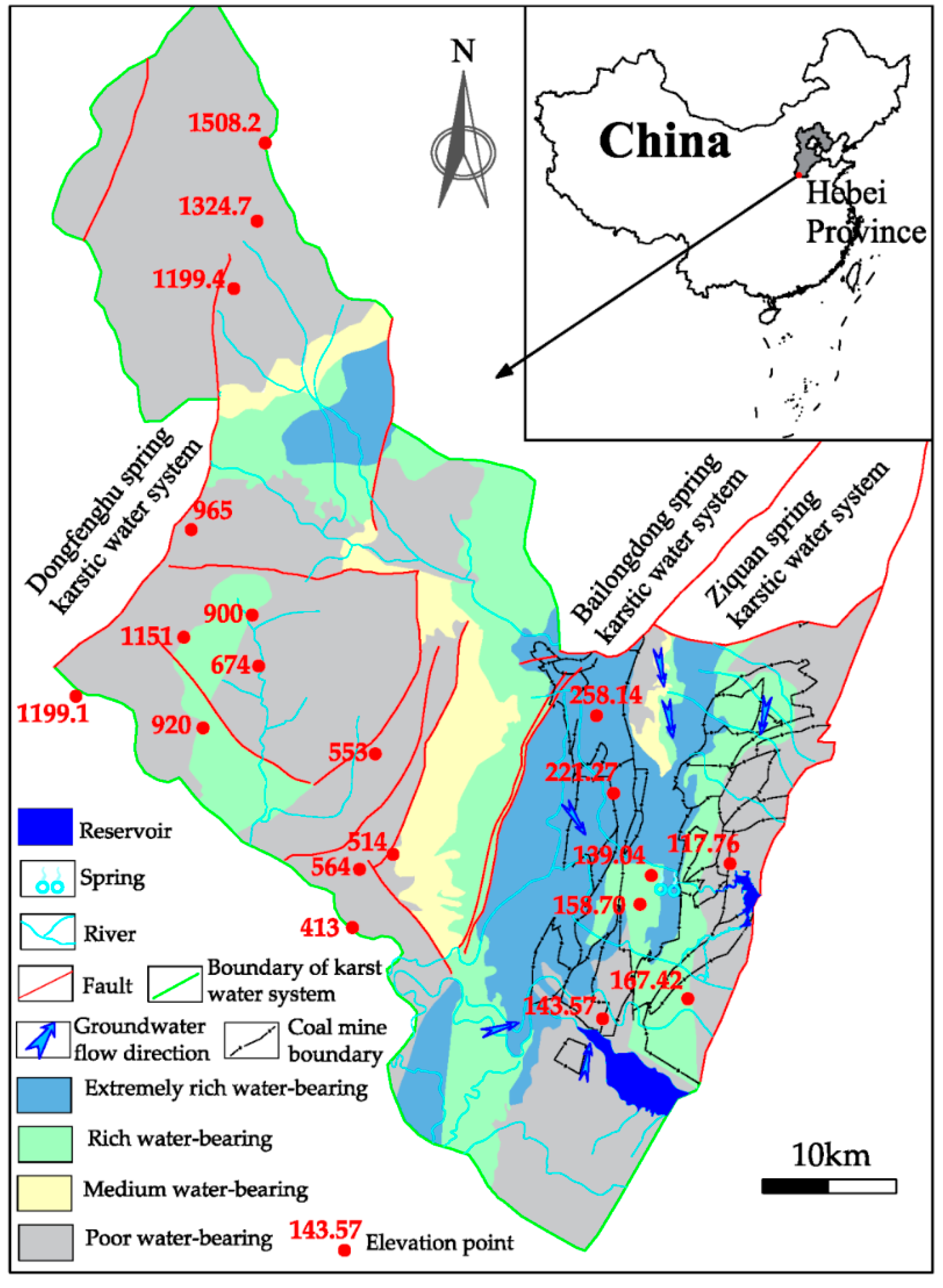
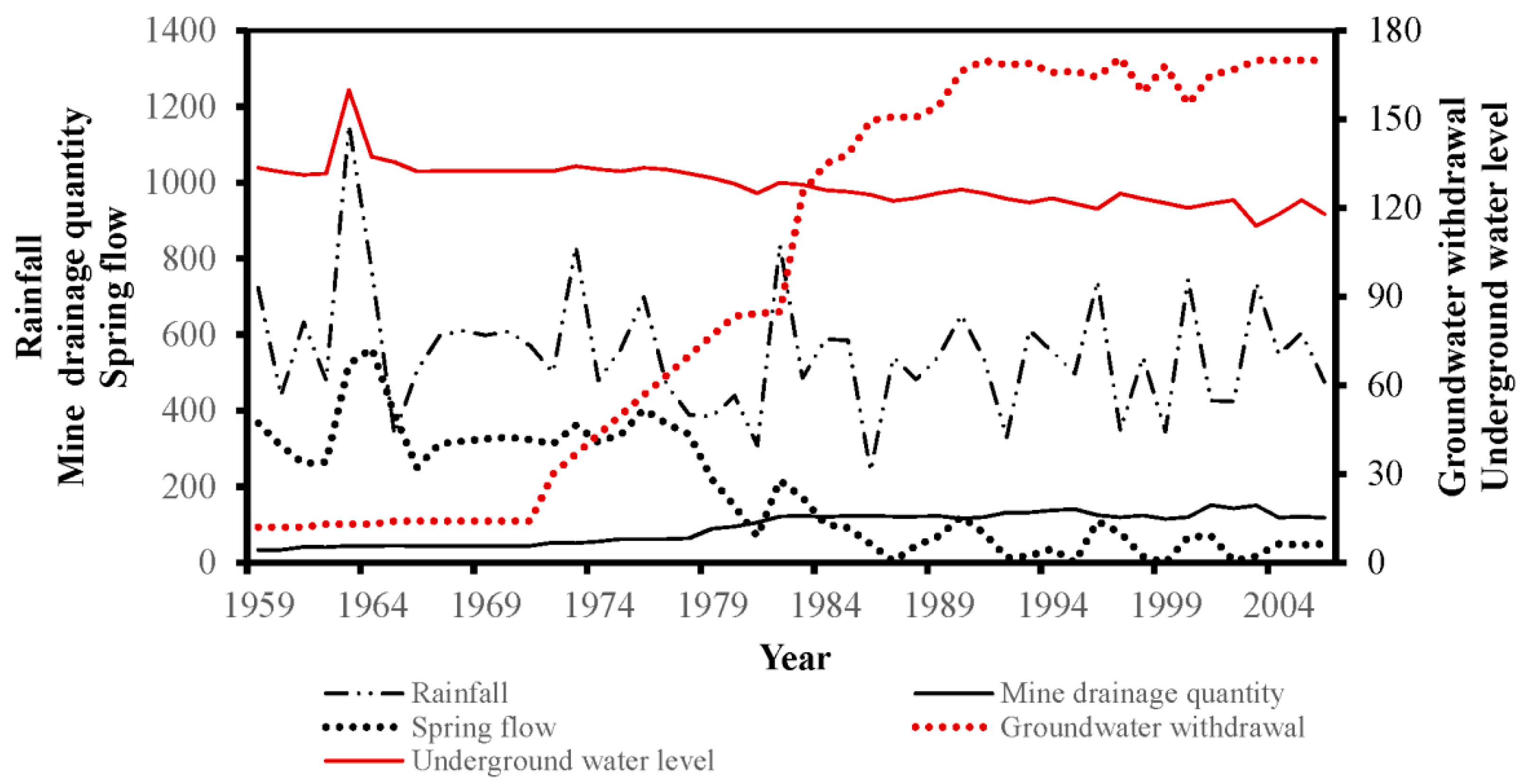
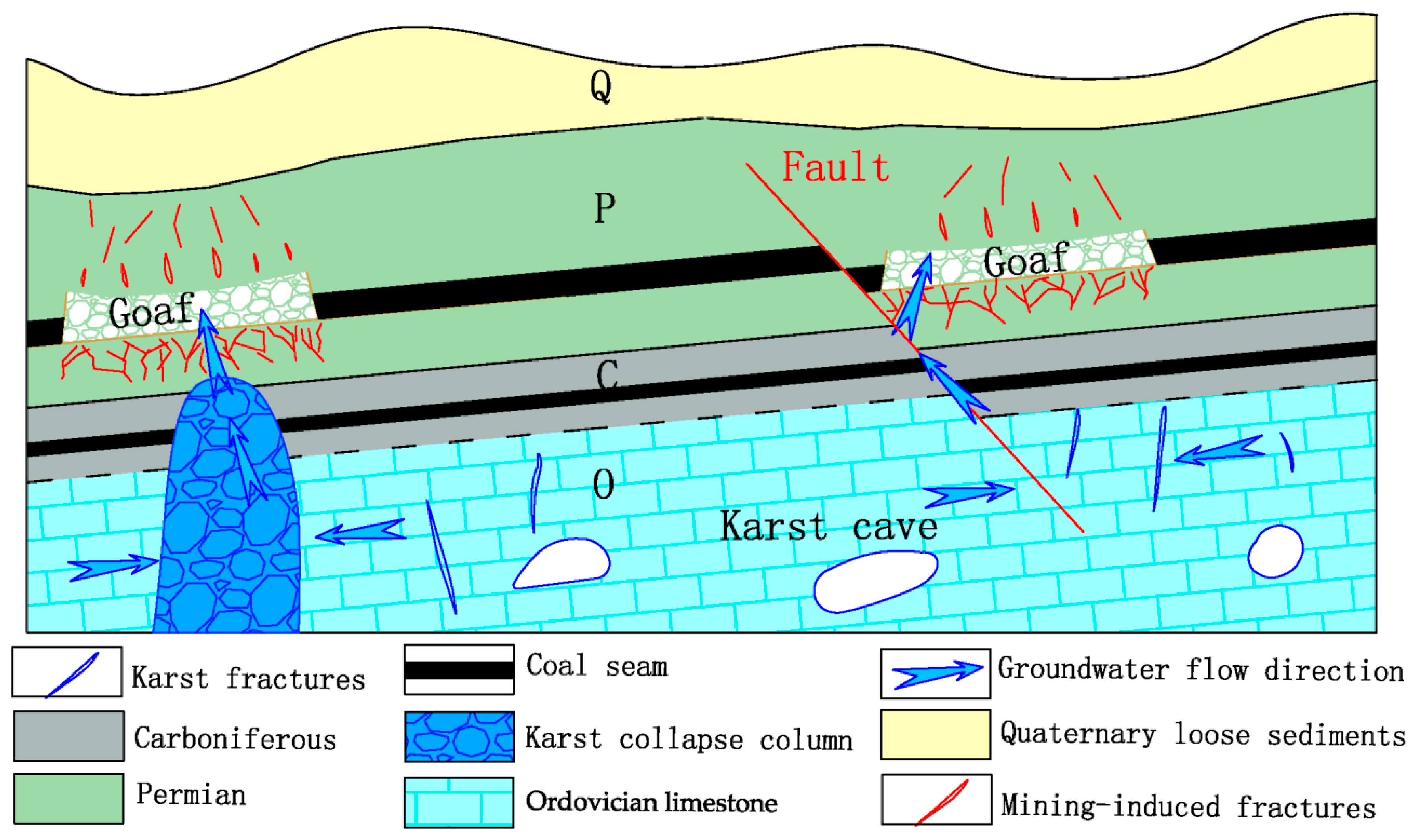
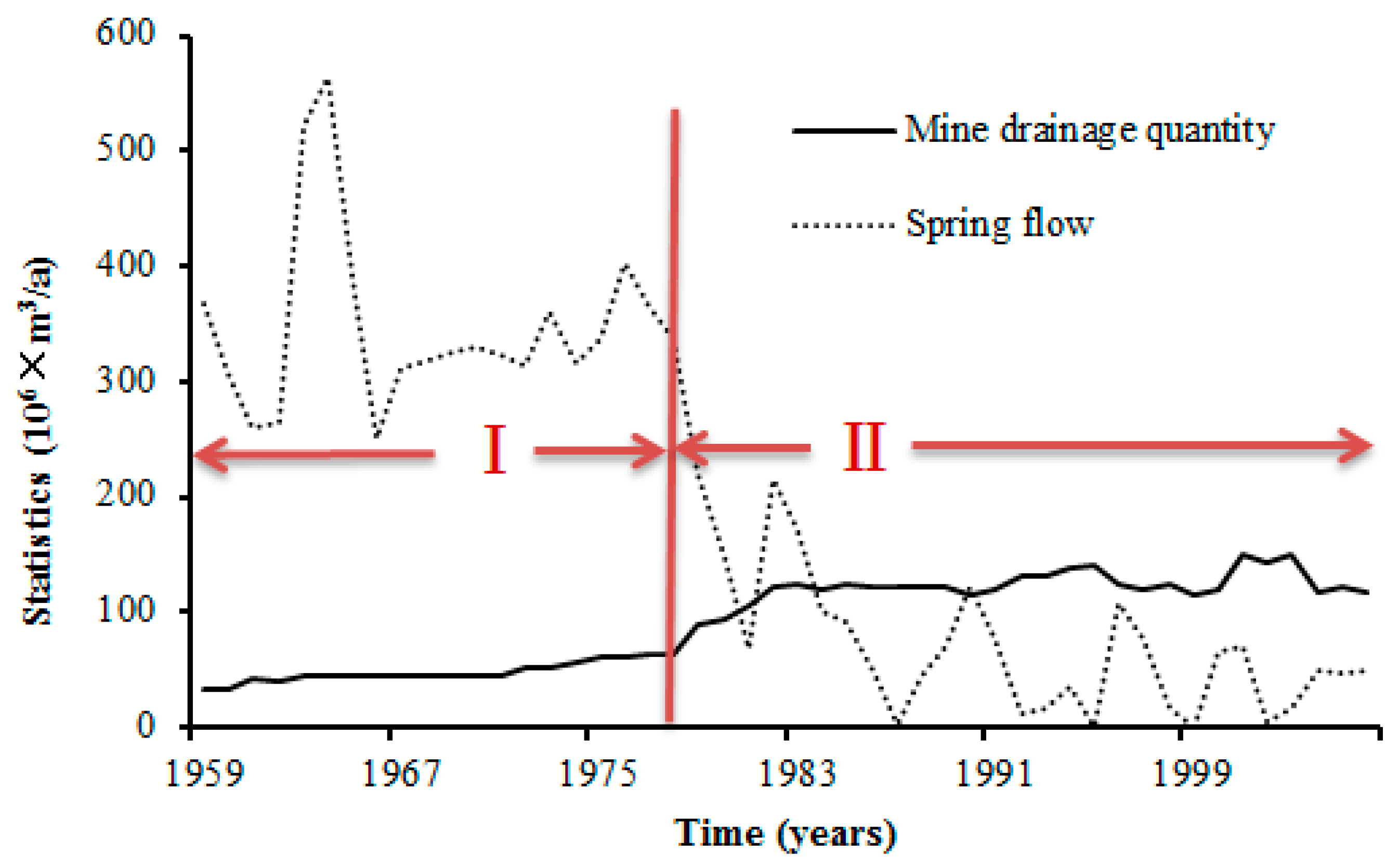
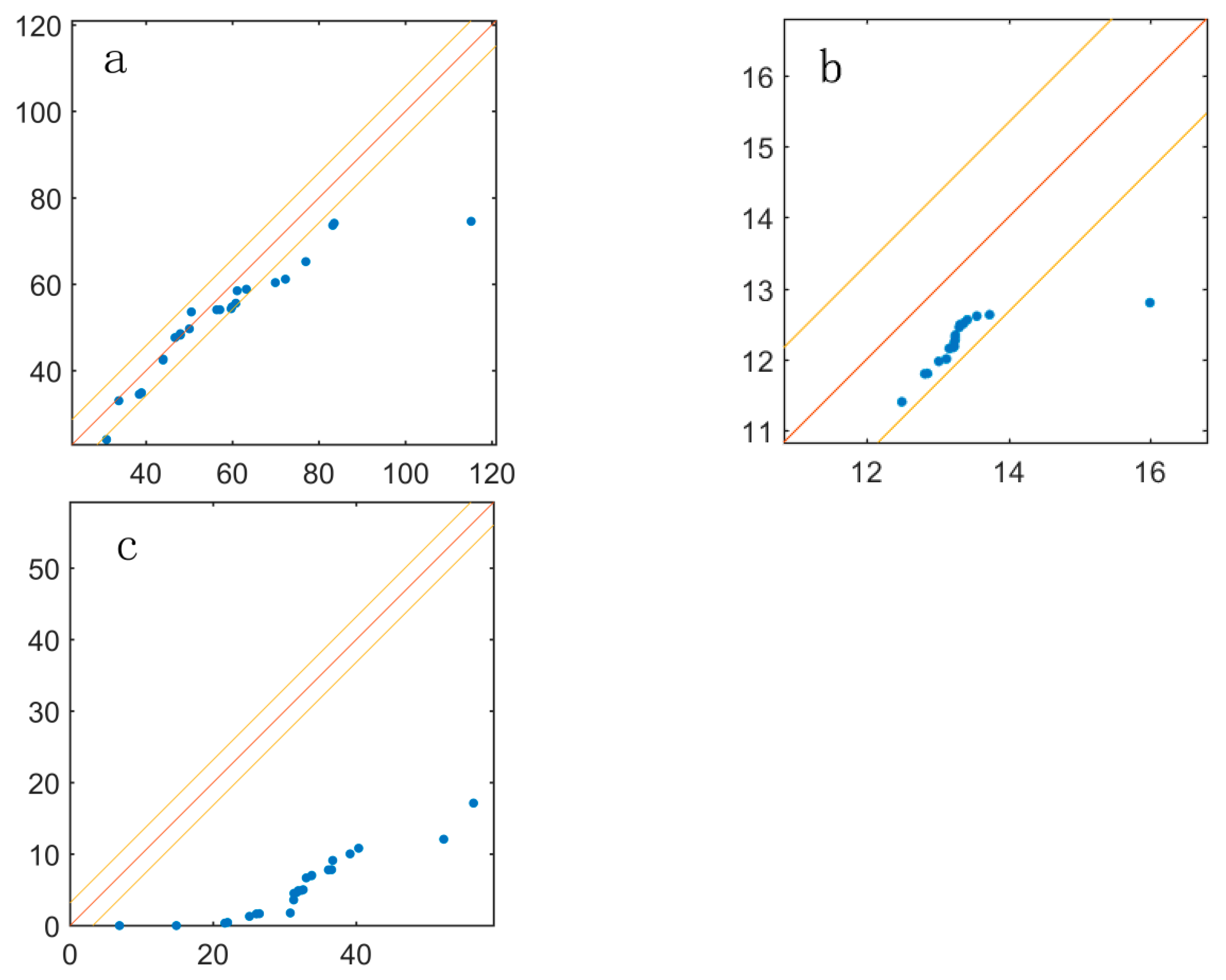
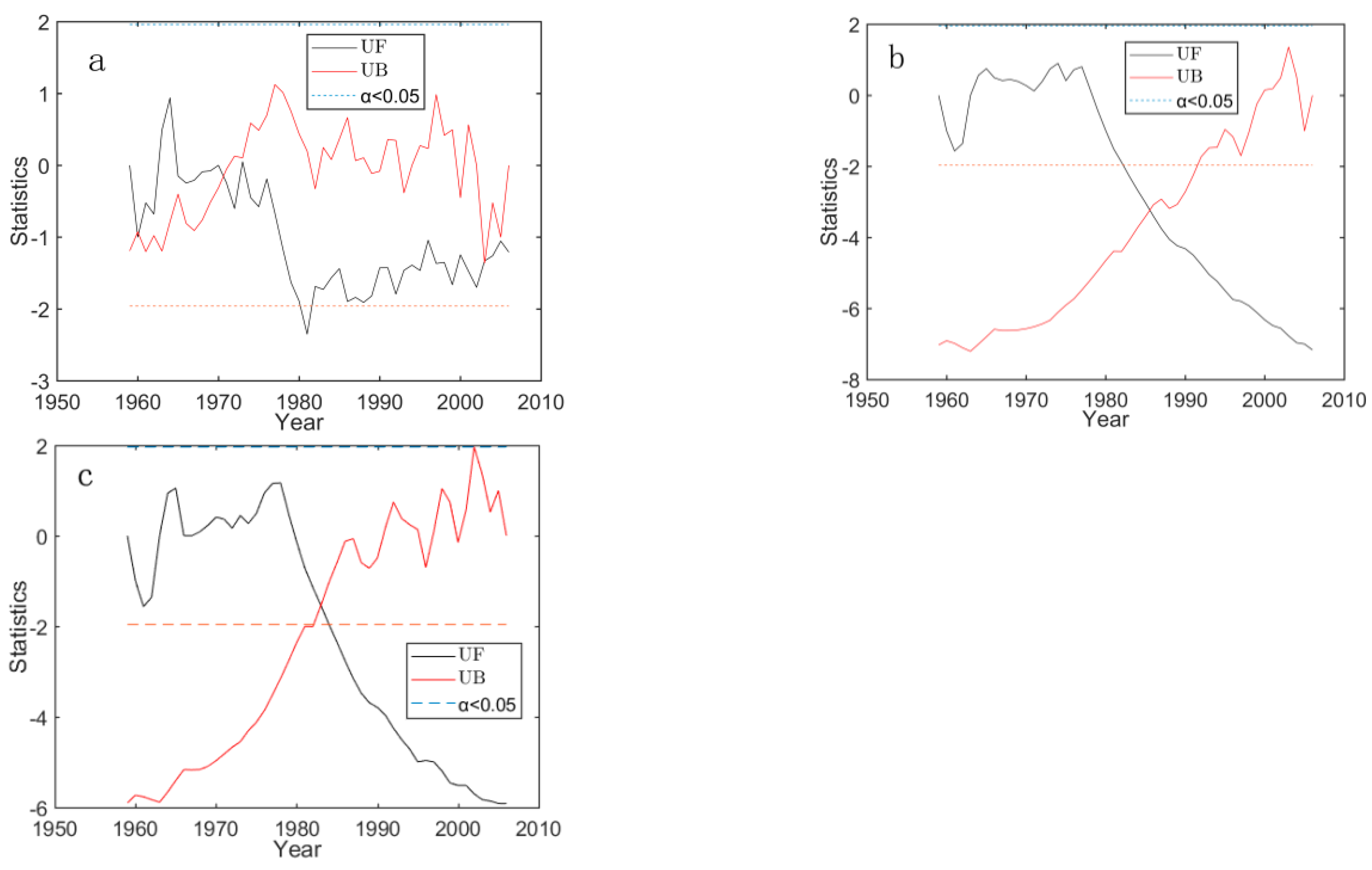
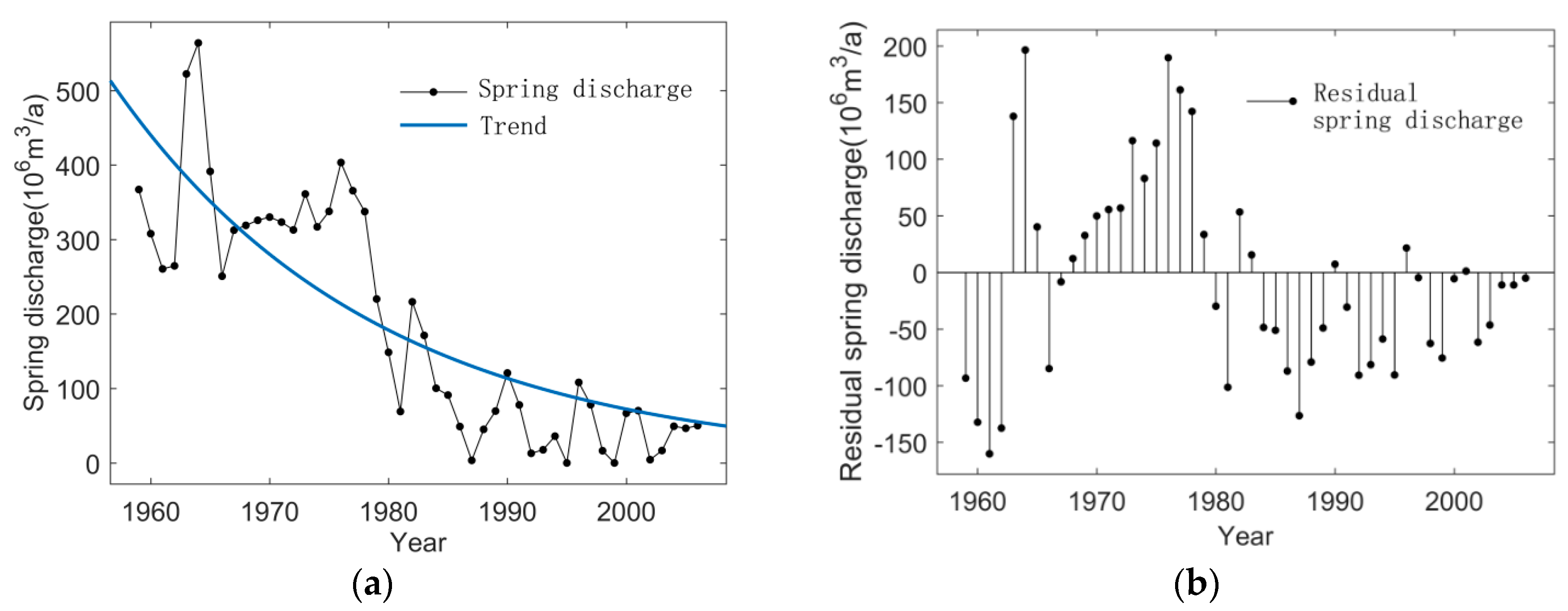
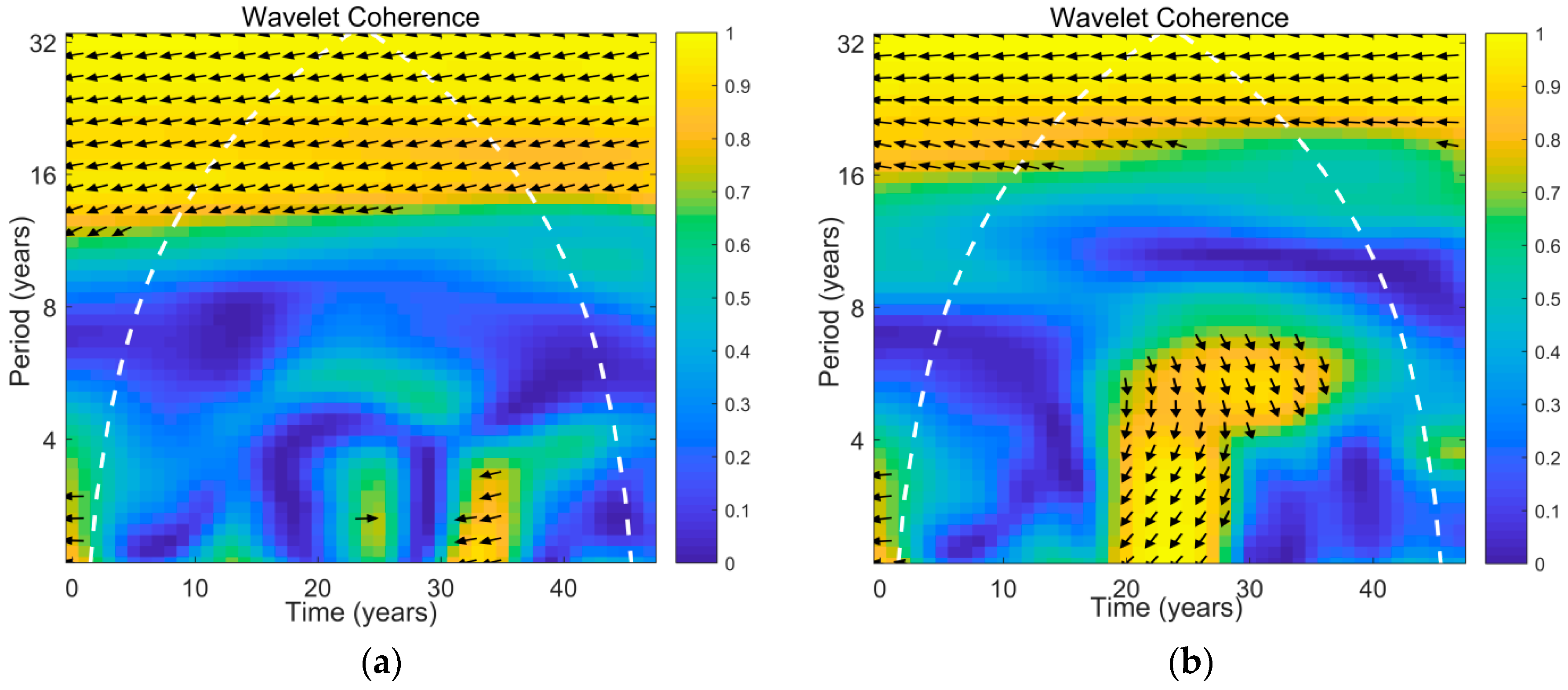
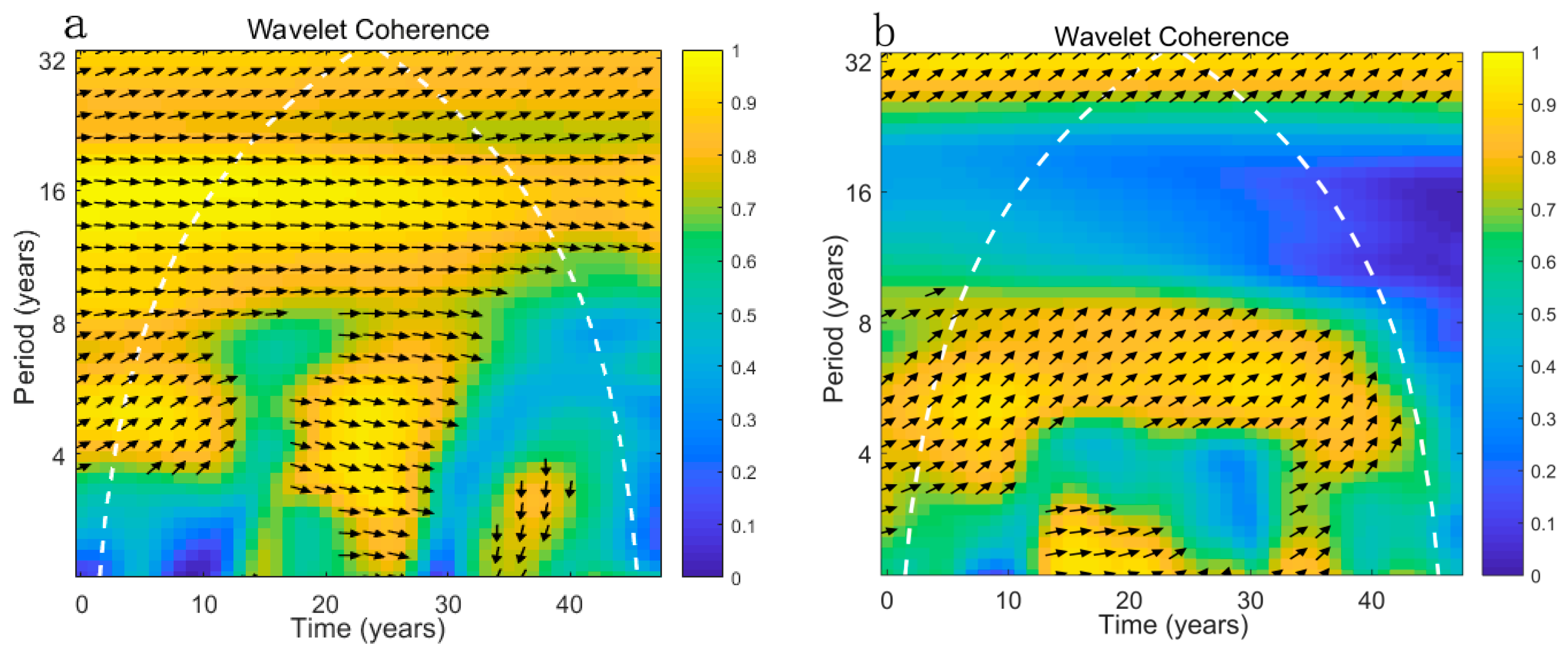
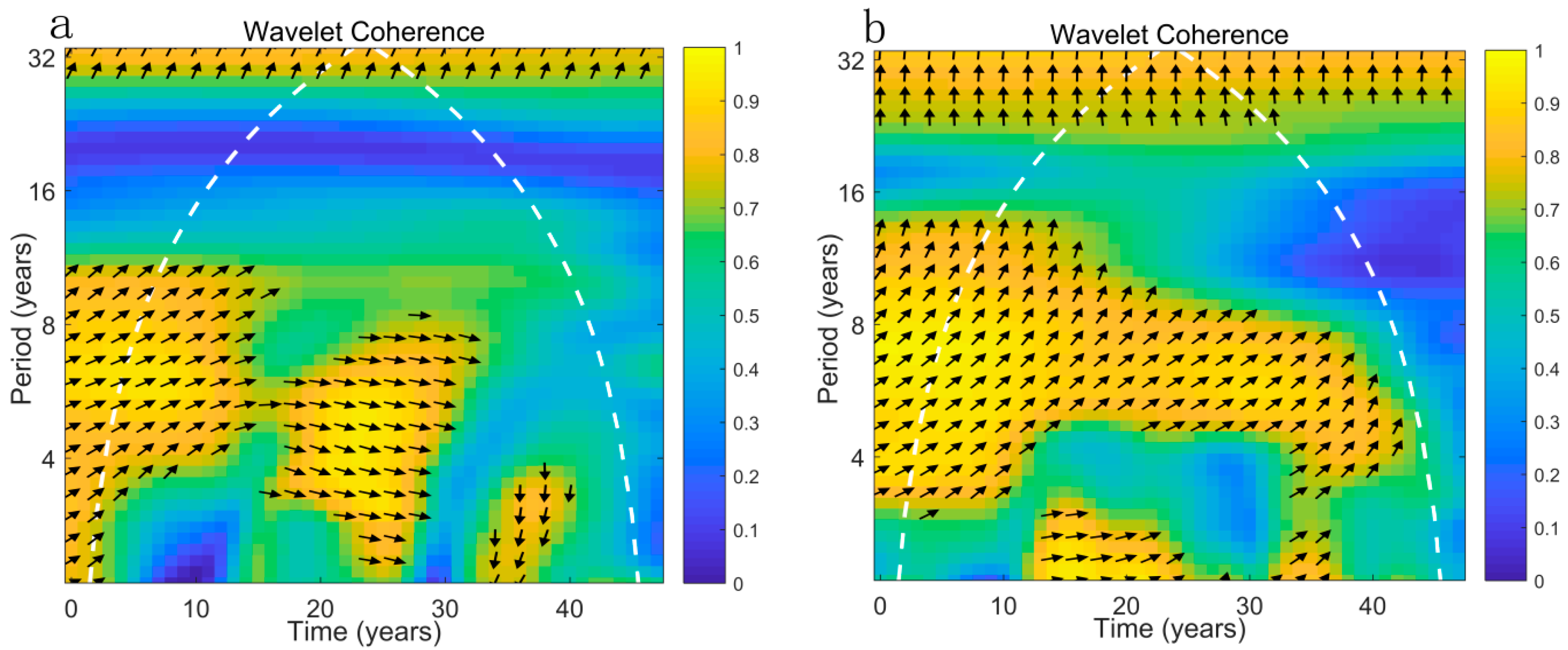
| Parameters | b | Z | D | |||
|---|---|---|---|---|---|---|
| Annual | Light | Moderate | Heavy | |||
| Rainfall | −2.34 | −1.19 | −0.96 | −0.31 | −0.27 | −1.88 |
| Mine drainage quantity | 2.57 *** | 7.10 *** | 12.23 | 13.63 | 13.45 | 10.37 |
| Groundwater withdrawal | 4.51 *** | 8.77 *** | 35.03 | 37.56 | 41.76 | 29.38 |
| Underground water level | −0.42 | −7.09 *** | −0.80 | −0.79 | −0.72 | −0.85 |
| Spring flow | −9.41 *** | −5.90 *** | −8.29 | −6.79 | −8.55 | −9.52 |
| Parameters | Rainfall | Mine Drainage Quantity | Groundwater Withdrawal | Underground Water Level | Spring Flow |
|---|---|---|---|---|---|
| Abrupt time | 1971 | 1973 | 1980 | 1986 | 1983 |
© 2018 by the authors. Licensee MDPI, Basel, Switzerland. This article is an open access article distributed under the terms and conditions of the Creative Commons Attribution (CC BY) license (http://creativecommons.org/licenses/by/4.0/).
Share and Cite
Huang, D.; Liu, Z.; Wang, W. Evaluating the Impaction of Coal Mining on Ordovician Karst Water through Statistical Methods. Water 2018, 10, 1409. https://doi.org/10.3390/w10101409
Huang D, Liu Z, Wang W. Evaluating the Impaction of Coal Mining on Ordovician Karst Water through Statistical Methods. Water. 2018; 10(10):1409. https://doi.org/10.3390/w10101409
Chicago/Turabian StyleHuang, Dan, Zaibin Liu, and Wenke Wang. 2018. "Evaluating the Impaction of Coal Mining on Ordovician Karst Water through Statistical Methods" Water 10, no. 10: 1409. https://doi.org/10.3390/w10101409




